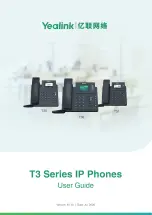
Key Concepts
93
All physical connections in an FDDI topology are
duplex links
(a pair of
insulated fiber-optic conductors). Both the FDDI ring and the ring of trees
that are created through concentrators are made up of duplex links.
Interconnect the nodes in an FDDI network to form at
most
one ring.
If a topology is legal, when physical connections and nodes fail or are
removed from the network, one or more legal FDDI topologies are
formed. So subsets of legal topologies are also legal. Examples of legal
FDDI topologies include the dual ring with trees, the dual ring without
trees, and the single tree. For information about legal topologies, see
“Setting the Connection Policies” later in this chapter.
Logical Topology: The Dual Ring
A legal FDDI topology consists of at most two separate logical rings: the
primary ring and the secondary ring. These logical rings are formed from
the physical links that make up the Physical Layer connections. For
example, a set of DASs that are connected into a closed loop form an
FDDI dual ring (that is, A to B; B to A). Each ring is a logical ring, that is, a
separate data path with its own token.
Functionally, the dual ring provides a high degree of reliability to a LAN.
When an FDDI network is in normal operation, only the primary ring
transmits and receives data. The secondary ring may also carry data, but it
is typically used as a backup in case there is a connectivity problem in the
primary ring or in one of the nodes on the ring.
When a single fault takes place on an FDDI dual ring, recovery can be
made by joining the two rings between the two nodes that are adjacent
to the fault. Doing this creates a single logical ring, which results in a
wrapped configuration. A wrapped ring is a legal FDDI topology. In the
same way, when many faults take place, several disjointed logical rings
are created, producing multiple FDDI topologies.
Nodes and
Attachments
An FDDI network is made up of stations, concentrators, and switches that
contain active services or management elements that conform to the
ANSI FDDI standards. These stations and concentrators are connected to
optical fiber medium and are attached in the prescribed manner set forth
in the FDDI standards to allow reliable data transmission. Connections are
made through FDDI ports and are managed by FDDI MACs.
Summary of Contents for CoreBuilder 3500
Page 44: ...44 CHAPTER 2 MANAGEMENT ACCESS ...
Page 58: ...58 CHAPTER 3 SYSTEM PARAMETERS ...
Page 86: ...86 CHAPTER 5 ETHERNET ...
Page 112: ...112 CHAPTER 6 FIBER DISTRIBUTED DATA INTERFACE FDDI ...
Page 208: ...208 CHAPTER 9 VIRTUAL LANS ...
Page 256: ...256 CHAPTER 10 PACKET FILTERING ...
Page 330: ...330 CHAPTER 12 VIRTUAL ROUTER REDUNDANCY PROTOCOL VRRP ...
Page 356: ...356 CHAPTER 13 IP MULTICAST ROUTING ...
Page 418: ...418 CHAPTER 14 OPEN SHORTEST PATH FIRST OSPF ...
Page 519: ...RSVP 519 Figure 94 Sample RSVP Configuration Source station End stations Routers ...
Page 566: ...566 CHAPTER 18 DEVICE MONITORING ...
Page 572: ...572 APPENDIX A TECHNICAL SUPPORT ...
Page 592: ...592 INDEX ...
















































